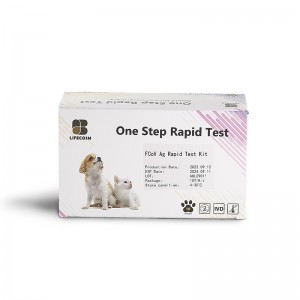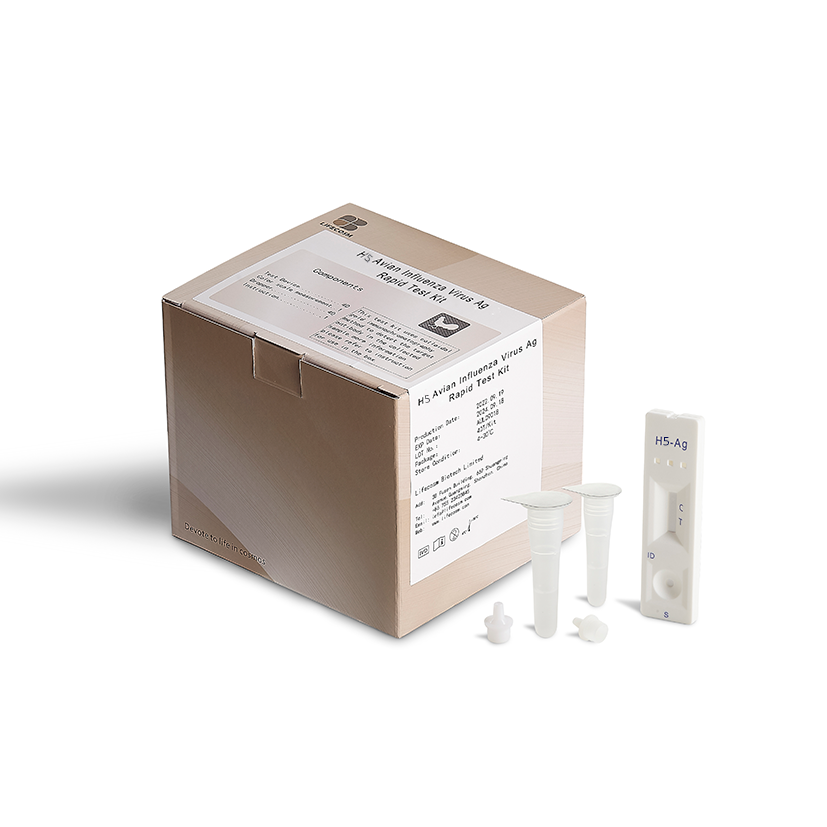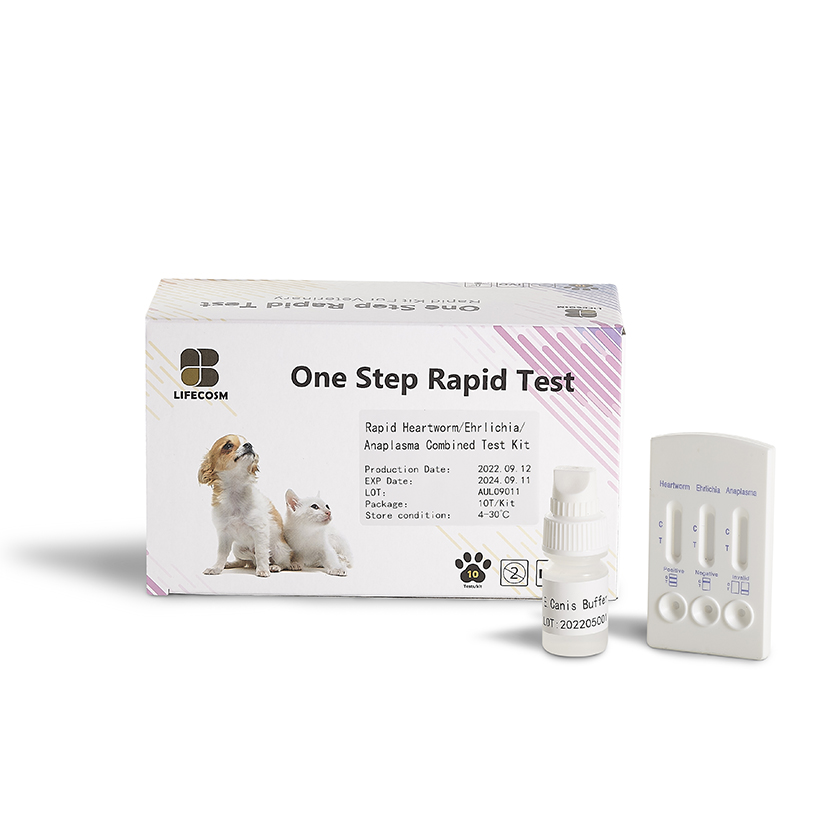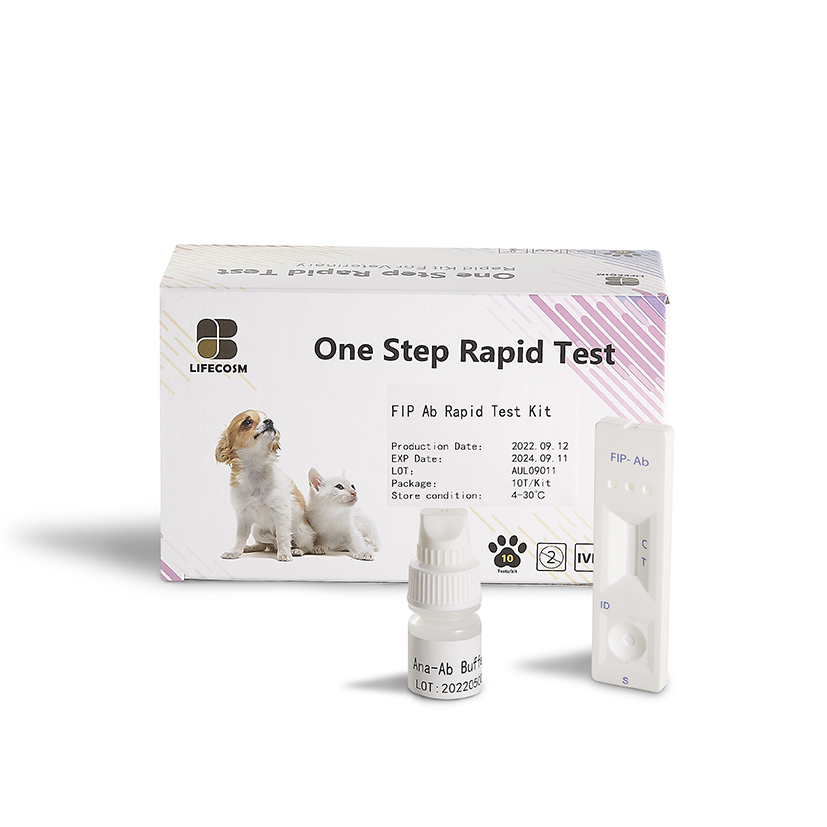
Products
Lifecosm Feline Leukemia Virus Ag/Feline Immunodeficiency Virus Ab Test Kit
Feline Leukemia Virus Ag/Feline Immunodeficiency Virus Ab Test Kit
| Catalog number | RC-CF15 |
| Summary | Detection of FeLV p27 antigens and FIV p24 antibodies within 15 minutes |
| Principle | One-step immunochromatographic assay |
| Detection Targets | FeLV p27 antigens and FIV p24 antibodies |
| Sample | Feline Whole Blood, Plasma or Serum |
| Reading time | 10 ~ 15 minutes |
| Sensitivity | FeLV : 100.0 % vs. IDEXX SNAP FIV/FeLV Combo Test FIV : 100.0 % vs. IDEXX SNAP FIV/FeLV Combo Test |
| Specificity | FeLV : 100.0 % vs. IDEXX SNAP FIV/FeLV Combo Test FIV : 100.0 % vs. IDEXX SNAP FIV/FeLV Combo Test |
| Limit of Detection | FeLV : FeLV recombinant protein 200ng/ml FIV : IFA Titer 1/8 |
| Quantity | 1 box (kit) = 10 devices (Individual packing) |
| Contents | Test kit, Buffer bottle, and Disposable droppers |
| Storage | Room Temperature (at 2 ~ 30℃) |
| Expiration | 24 months after manufacturing |
|
Caution |
Use within 10 minutes after opening Use appropriate amount of sample (0.02 ml of a dropper for FeLV/0.01 ml of a dropper for FIV ) Use after 15~30 minutes at RT if they are stored under cold circumstances Consider the test results as invalid after 10 minutes |
Information
Fenine Coronavirus (FCoV) is a virus that affects the intestinal tract of Cats. It causes a gastroenteritis similar to parvo. FCoV is the second leading viral cause of diarrhea in Cats with canine Parvovirus (CPV) being the leader. Unlike CPV, FCoV infections are not generally associated with high death rates. .
FCoV is a single stranded RNA type of virus with a fatty protective coating. Because the virus is covered in a fatty membrane, it is relatively easily inactivated with detergent and solvent-type disinfectants. It is spread by virus shedding in the feces of infected dogs. The most common route of infection is contact with fecal material containing the virus. Signs begin to show 1-5 days after exposure. The dog becomes a “carrier” for several weeks after recovery. The virus can live in the environment for several months. Clorox mixed at a rate of 4 ounces in a gallon of water will destroy the virus.
Symptoms
Feline leukemia virus (FeLV), a retrovirus, so named because of the way it behaves within infected cells. All retroviruses, including feline immunodeficiency virus (FIV) and human immunodeficiency virus (HIV), produce an enzyme, reverse transcriptase, which permits them to insert copies of their own genetic material into that of the cells they have infected. Although related, FeLV and FIV differ in many ways, including their shape: FeLV is more circular while FIV is elongated. The two viruses are also quite different genetically, and their protein constituents are dissimilar in size and composition. Although many of the diseases caused by FeLV and FIV are similar, the specific ways in which they are caused differs.
FeLV-infected cats are found worldwide, but the prevalence of infection varies greatly depending on their age, health, environment, and lifestyle. In the United States, approximately 2 to 3% of all cats are infected with FeLV. Rates rise significantly—13% or more—in cats that are ill, very young, or otherwise at high risk of infection.
Transmission
Cats persistently infected with FeLV serve as sources of infection. Virus is shed in very high quantities in saliva and nasal secretions, but also in urine, feces, and milk from infected cats. Cat-to-cat transfer of virus may occur from a bite wound, during mutual grooming, and (though rarely) through the shared use of litter boxes and feeding dishes. Transmission can also take place from an infected mother cat to her kittens, either before they are born or while they are nursing. FeLV doesn't survive long outside a cat's body— probably less than a few hours under normal household conditions.

Symptoms
During the early stages of infection, it is common for cats to exhibit no signs of disease at all. However, over time—weeks, months, or even years—the cat's health may progressively deteriorate or be characterized by recurrent illness interspersed with periods of relative health. Signs are as follows:
Loss of appetite.
Slow but progressive weight loss, followed by severe wasting late in the disease process.
Poor coat condition.
Enlarged lymph nodes.
Persistent fever.
Pale gums and other mucus membranes.
Inflammation of the gums (gingivitis) and mouth (stomatitis)
Infections of the skin, urinary bladder, and upper respiratory tract.
Persistent diarrhea.
Seizures, behavior changes, and other neurological disorders.
A variety of eye conditions, and In unspayed female cats, abortion of kittens or other reproductive failures.
Diagnosis
The preferred initial tests are soluble-antigen tests, such as ELISA and other immunochromatographic tests, that detect free antigen in fluid. Testing for the disease can easily be performed. Soluble-antigen tests are most reliable when serum or plasma, rather than whole blood, is tested. In experimental settings most cats will have positive results with soluble-antigen test within
28 days after exposure; however the time between exposure and development of antigenemia is extremely variable and may be considerably longer in some instances. Tests using saliva or tears yield an unacceptably high percentage of inaccurate results and their use is not recommended. For a feline testing negative for the disease a preventive vaccine can be administered. The vaccine, which is repeated once every year, has an incredibly high success rate and is currently (in the absence of an effective cure) the most potent weapon in the fight against feline leukemia.
Prevention
The only sure way to protect cats is to prevent their exposure to the virus. Cat bites are the major way infection is transmitted, so keeping cats indoors- and away from potentially infected cats that might bite them-markedly reduces their likelihood of contracting FIV infection. For the safety of the resident cats, only infection-free cats should be adopted into a household with uninfected cats.
Vaccines to help protect against FIV infection are now available. However, not all vaccinated cats will be protected by the vaccine, so preventing exposure will remain important, even for vaccinated pets. In addition, vaccination may have an impact on future FIV test results. It is important that you discuss the advantages and disadvantages of vaccination with your veterinarian to help you decide whether FIV vaccines should be administered to your cat.










